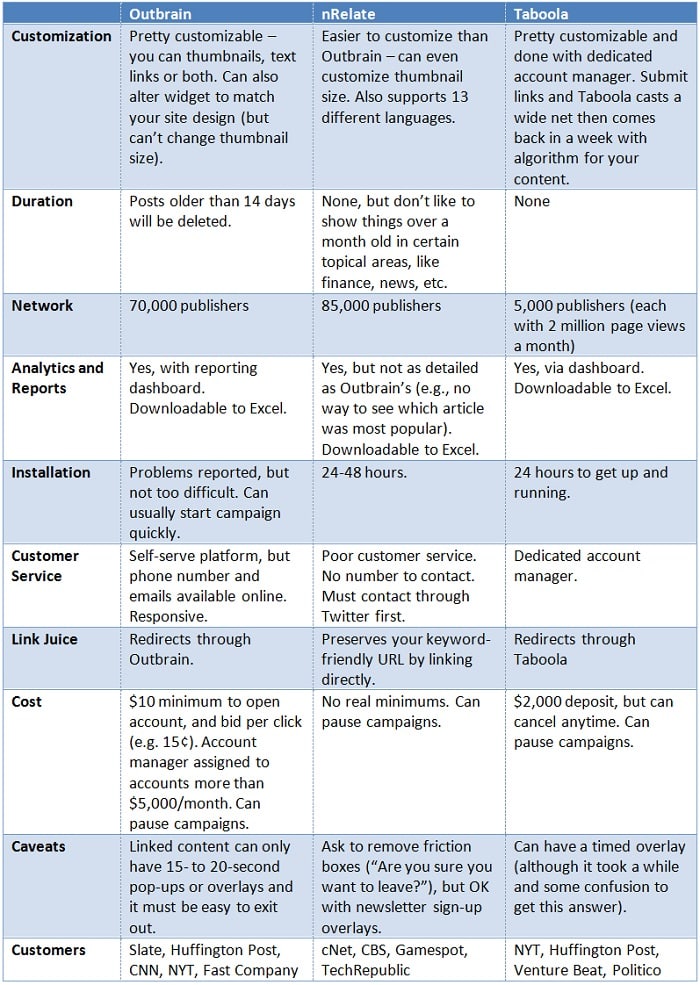Recommendation engines — also called paid discovery — are making it easier for online publishers to target audiences who have already expressed some interest in a topic. In this How-To, we explain the three types of recommendation engines out there, list five reasons you’d want to use them, and warn you about the four possible problems subscription sites can have with them. Plus, we’ve created a super handy comparative table of the three major vendors in this space — Outbrain, nRelate and Taboola. This How-To is equally relevant to B2B and B2C sites, as well as text-heavy and video content, so discover how you can boost traffic to your site by up to 12% today!
What are Recommendation Engines?
When it comes to discovering content, search and SEO came first. Then came social media and peer recommendations. Now there’s recommendation engines — algorithms that recommend topically-related content.
Recommendation engines are platforms or plugins that automatically recommend content to site visitors based on the site visitor’s previous viewing history and other site visitors’ activity. Recommendation engines use complex algorithms to make these recommendations, often using information gleaned from cookies and ISP data.
In short, recommendation engines allow your relevant content to appear in a highly visible location within third-party sites — if you pay for the privilege.
3 Types of Recommendation Engines
There are three main types of recommendation engines, based on the type of content they recommend:
- Internal recommendation engines: When a site visitor lands on a page on your site, these recommendation engines suggest content from your site in order to keep the visitor engaged by simplifying discovery of more relevant content (and sometimes to make additional purchases). The best examples are seen on Amazon and Netflix, who have developed their own in-house code to create and run these recommendations (e.g., “users who viewed this also liked ”). LinkWithin is a free WordPress plugin that anyone can use that serves the same purpose for content recommendations.
- Third-party recommendation engines: These platforms and plugins place thumbnails and text links on third-party sites linking to your content. Major players include Outbrain, nRelate and Taboola. The focus of the article is on this type of recommendation engine.
- Advertising recommendation engines: These platforms and plugins are like third-party recommendation engines, except they link to advertorials and sponsored content. Major vendors include AdBlade and ContentAd. (A bit like Google’s AdSense, but instead of straight advertising, these platforms host ads with some sort of editorial content.)
Recommendation engines usually place their photo or video thumbnails and text links at the end of an article, or after viewing a video. Here are two examples, one of Outbrain’s recommended content at the end of an article on CNN, and the second a set of video recommendations hosted by Taboola that appeared after viewing a video on The New York Times.


Note: When recommendation engines work with publishers, they often use 50/50 splits, which means that 50% of the recommendations will be for internal content (i.e., more CNN content) and 50% will be for content from around the Web. When you use a recommendation engine to get discovered on third-party sites, your content is typically listed as “From Around the Web” and grouped with other content.
Should You Use Recommendation Engines?
Unlike search, recommendation engines do not require mass popularity in order for your content to shoot to the top of a list; instead, topical relevance and behavioral algorithms determine that. And unlike social media, your content doesn’t need to go viral to land in the right hands. Rather, other site visitors with similar interests will help make your content link visible to the right audience.
Print subscription marketers will remember that it’s often best to work with competitors since, for example, a reader who subscribes to one financial publication will likely subscribe to another seven or eight. Recommendation engines are adopting the same paradigm for online content since readers and viewers who consume one type of content are likely looking for more like it.
In fact, initial benchmarks make recommendation engines look like a promising way for content publishers to get discovered (note that some of these figures are from the recommendation platforms themselves):
- Between August and November of 2012, 76% of U.S. adults clicked on links to related stories for more information.
- Recommendation engines can get a traffic spike of somewhere between 5%-12% (average is 8%)
- 31% of online consumers indicate search engines are not the primary sources for finding content
- 48% of online consumers say that after reading an article, they are more likely to click on related content
- The likelihood of a reader clicking through to related or suggested content differs based on the subject matter:
Local News: 84% are likely to click on a related link;
National News: 78% are likely to click on a related link;
Entertainment: 62% are likely to click on a related link;
Sports: 47% are likely to click on a related link
Note: While the data appears to support the use of recommendation engines to promote B2C content, B2B content is equally benefited by this marketing method. In fact, some B2B sites, like The Hollywood Reporter and financial publications, are able to leverage the more voluminous traffic of B2C sites to get more exposure to audiences that may be interested but unaware of B2B sites’ relevance to a topic.
5 Advantages for Subscription Content Sites
- Recommendation engines let your content (text, slideshows, video) live longer than a day, tying it to related content instead of the day’s headlines. (Note: Some recommendation engines don’t take content more than 2 weeks old; see our Comparison Chart below for details.)
- Most recommendation engine platforms have flexible pricing, making them as cost-effective as PPC.
- You can test what content brings in the most new visitors by creating different headlines. The recommendation engines will test them all and then choose the one or two that get the most visitors.
- Your content is automatically targeted by consumer behavior, not your assumptions about your audience.
- You can target by geographic location, and can opt-out of appearing on certain sites if you don’t feel they’re relevant.
4 Potential Problems for Subscription Content Sites
- Unlike social media, you can’t target based on demographics, like age, gender, etc. But given the behavioral targeting aspects of this technology, this is a lesser concern.
- You can only link to HTML content; no PDFs.
- You can only link to free content, not paywalled.*
- Content guidelines are not always specific or written, and can vary on a case-by-case basis.**
*Linking to premium content is, for the most part, not possible. Recommendation engines want a seamless consumer experience where a visitor doesn’t have to input anything — a name, an email address, a credit card — to be able to view content. However, metered sites can get around this by making sure traffic coming from recommendation sites can get through, even if the particular visitor has surpassed their monthly meter allotment.
Hard paywalled sites face a tougher challenge. However, they can offer up free content with a sidebar enticing visitors to sign up for a newsletter, trial, or premium subscription. Just make sure there’s quality content on the page. Because most recommendation engine vendors screen content on a case by case basis, they can refuse anything too promotional or used solely for lead generation purposes.
** In addition, recommendation engines can refuse content based on type or their own preferences. Most do not allow gambling or pornography, and some prohibit content about guns or violence. But they’ll also prohibit other types of content, or specific articles, for a variety of reasons (or decide not to give you a reason). Content related to financial services and health get particular scrutiny and can be rejected for simply being perceived as bad advice or “scamm-y.”
At the same time, advertorial or branded content is sometimes accepted, if it meets the recommendation engines idea of ‘quality content that engages readers.’
Our best advice? Submit your content and see what happens. But if it’s rejected, don’t go re-working all your content to get accepted since you have subscribers already willing to pay for what you create.
Cost Structure
Most recommendation engines work like traditional PPC. They require an initial deposit, anywhere from $10 to $2,000. You then bid on how much you’re willing to pay for click from a third-party site (you can’t bid on separate sites, just overall), usually around 15-20 cents to start.
Most of the platforms also allow you to cap and pace spending.
Below we compare the three major providers of recommendation engines.
Comparison Chart: Outbrain, nRelate, Taboola








